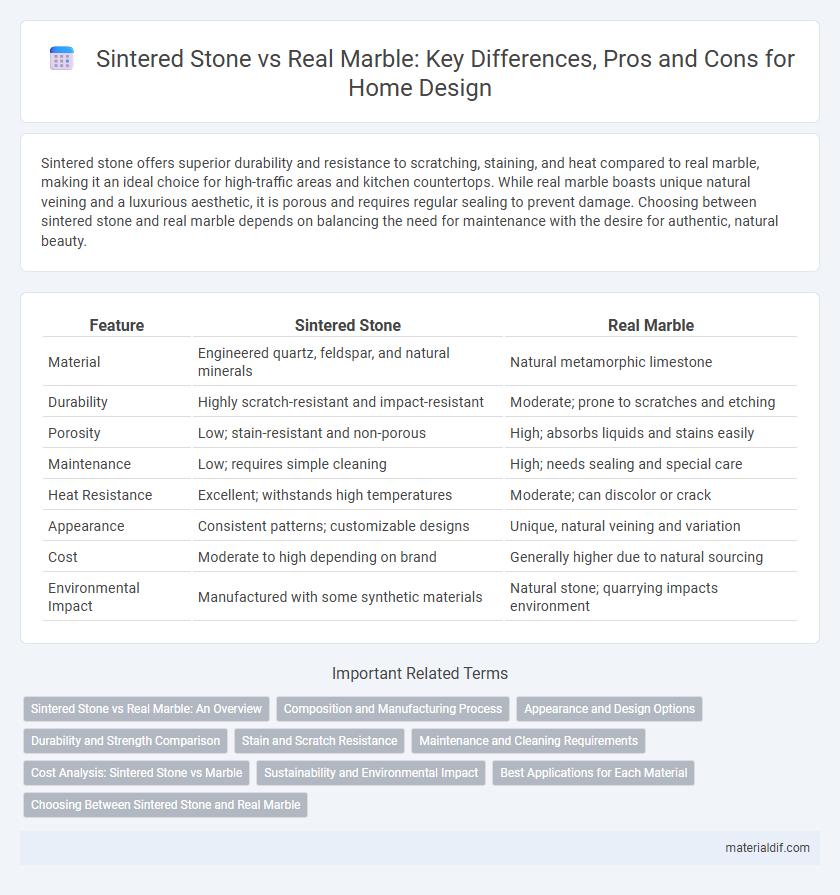Sintered stone offers superior durability and resistance to scratching, staining, and heat compared to real marble, making it an ideal choice for high-traffic areas and kitchen countertops. While real marble boasts unique natural veining and a luxurious aesthetic, it is porous and requires regular sealing to prevent damage. Choosing between sintered stone and real marble depends on balancing the need for maintenance with the desire for authentic, natural beauty.
Table of Comparison
| Feature | Sintered Stone | Real Marble |
|---|---|---|
| Material | Engineered quartz, feldspar, and natural minerals | Natural metamorphic limestone |
| Durability | Highly scratch-resistant and impact-resistant | Moderate; prone to scratches and etching |
| Porosity | Low; stain-resistant and non-porous | High; absorbs liquids and stains easily |
| Maintenance | Low; requires simple cleaning | High; needs sealing and special care |
| Heat Resistance | Excellent; withstands high temperatures | Moderate; can discolor or crack |
| Appearance | Consistent patterns; customizable designs | Unique, natural veining and variation |
| Cost | Moderate to high depending on brand | Generally higher due to natural sourcing |
| Environmental Impact | Manufactured with some synthetic materials | Natural stone; quarrying impacts environment |
Sintered Stone vs Real Marble: An Overview
Sintered stone offers enhanced durability, resistance to scratches, stains, and heat compared to real marble, making it ideal for high-traffic areas and kitchen surfaces. Unlike real marble, which is susceptible to etching and requires regular sealing, sintered stone is non-porous and low-maintenance, providing a consistent color and pattern due to its engineered production. Both materials offer aesthetic appeal, but sintered stone's versatility and superior performance make it a practical alternative for modern architectural and design projects.
Composition and Manufacturing Process
Sintered stone is made from a blend of natural minerals like quartz, feldspar, and porcelain, subjected to high pressure and temperature to create a dense, non-porous surface. Real marble consists mainly of calcite, formed through the metamorphism of limestone over millions of years, resulting in a softer, porous stone. The manufacturing process of sintered stone uses advanced technology for durability and uniformity, while real marble undergoes quarrying and cutting, preserving its unique natural veining.
Appearance and Design Options
Sintered stone offers a wide range of colors, patterns, and textures that closely mimic real marble, providing versatile design options without the natural inconsistencies found in marble slabs. Real marble features unique veining and natural variations that add character and a luxurious aesthetic but can limit uniformity across large surfaces. Designers favor sintered stone for its consistency and customizable finishes, while marble remains a preferred choice for authentic elegance and traditional appeal.
Durability and Strength Comparison
Sintered stone exhibits superior durability and strength compared to real marble due to its engineered composition, making it highly resistant to scratches, stains, and heat. Real marble, a natural stone, tends to be softer and more porous, which leads to susceptibility to scratching, staining, and etching over time. The compact structure of sintered stone enhances its mechanical resistance, making it ideal for high-traffic or heavy-use surfaces where long-lasting performance is essential.
Stain and Scratch Resistance
Sintered stone offers superior stain and scratch resistance compared to real marble, making it ideal for high-traffic areas and surfaces exposed to daily wear. Unlike marble, which is porous and prone to etching from acidic substances, sintered stone is non-porous and chemically inert, preventing absorption and discoloration. Its enhanced durability ensures long-lasting aesthetic appeal without the frequent need for sealing or maintenance required by natural marble.
Maintenance and Cleaning Requirements
Sintered stone offers superior resistance to stains and scratches, requiring minimal maintenance compared to real marble, which is porous and prone to etching and staining. Regular sealing and gentle cleaning with pH-neutral products are essential for real marble to preserve its appearance, while sintered stone can be cleaned with common household detergents without damage. The durability of sintered stone reduces the need for frequent upkeep, making it a practical choice for high-traffic areas.
Cost Analysis: Sintered Stone vs Marble
Sintered stone offers a more cost-effective alternative to real marble, with prices averaging 30-50% lower due to its manufacturing process and material efficiency. Real marble involves higher expenses not only in material costs but also in installation and maintenance, as it requires sealing and frequent care to prevent staining and etching. The durability and low maintenance of sintered stone reduce long-term costs, making it a budget-friendly option without compromising aesthetic appeal.
Sustainability and Environmental Impact
Sintered stone offers a sustainable alternative to real marble by utilizing natural minerals combined with eco-friendly production processes that reduce waste and energy consumption. Unlike real marble, which involves extensive quarrying and habitat disruption, sintered stone's manufacturing minimizes environmental degradation and supports resource efficiency. Its durability and low porosity also contribute to longer lifecycle and reduced maintenance, further enhancing its environmental benefits.
Best Applications for Each Material
Sintered stone is ideal for high-traffic areas such as kitchen countertops, flooring, and exterior cladding due to its superior durability, stain resistance, and low maintenance requirements. Real marble excels in decorative applications like bathroom vanities, fireplace surrounds, and elegant wall panels where its natural veining and classic beauty enhance aesthetic appeal. Choosing between sintered stone and real marble depends on balancing functional demands with desired visual impact in residential or commercial projects.
Choosing Between Sintered Stone and Real Marble
Choosing between sintered stone and real marble depends on durability, maintenance, and aesthetic preferences. Sintered stone offers superior resistance to scratches, stains, and heat, making it ideal for high-traffic areas and kitchens, while real marble provides unique natural veining and a luxurious appearance but requires regular sealing and careful maintenance. Assessing the balance between durability needs and the desire for authentic natural beauty guides the best choice for flooring, countertops, or wall cladding.
Sintered stone vs real marble Infographic

 materialdif.com
materialdif.com